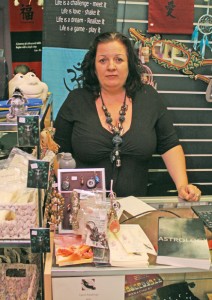
These days, Hallowe’en is a time for costumed antics for all ages. Everyone knows the origins of the festival – a holdover from the days of our ancestors who believed the world of the supernatural was “close at hand”. It is one of the four major holidays of the Celtic year, whose original name is Samhain, and the building and gathering around a bonfire is a tradition older than Christianity.
For some, however, Hallowe’en is more than just a holdover from days gone by. NewsFour went in search of contemporary “pagans” whose traditions have been revitalised and reinvented to fit the times.
On Crow Street in Temple Bar we find The Black Rabbit – “a magical little shop”. Behind the counter is Rachel Butler, proprietress with her husband Stuart. She describes herself variously, and often with hearty laughter, as a “hedge witch” or “a kitchen witch”. Does that mean she’s a Wiccan? Apparently not: Rachel explains the broad divisions, as she sees them.
There are the Wiccans, formal orders of practising witches who operate in a coven structure; and there is “the High Magick crowd”, ceremonial lodges like the Golden Dawn and the Ordo Templi Orientis, enshrined in popular imagination by their association with people like W. B. Yeats and Maud Gonne on one hand, and the infamous Aleister Crowley on the other.
“There’s a lot of work going on between Druidry and the Trad Witches at the moment – we all have more in common than we realised, I think. Practising together showed us that. Paying attention to the land, what the stars are doing, and having a tradition which is passed on in a lineage.” For her part, Rachel feels that the traditional strand represents “witches as they would have been” in the days of the pre-Medieval era of midwives and wise men or women. “We use roots, powders, herbs and oils in our magic, we do divination.” Commonly known as fortune-telling, divination methods involve interpretation of oracular devices like Tarot cards, or the Nordic magical alphabet known as Runes. “We might also do healing work. There’s no coven structure, no initiations; you either are or you aren’t. The tradition involves learning from each other and gleaning knowledge from everything.”
For Rachel, Samhain retains a pre-Christian significance of being a harvest festival. “It would have been the time of year where there’d be no more fresh food that year; it all would have been stored for winter.” Winter was when nature, in a sense, dies, Rachel explains, so Samhain was the point where the world of the dead drew closer to the living.
Rachel’s tradition is inherited from her mother and grandmother. She remembers bobbing for apples. “We’d peel them and do divinations with the skins. Her grandfather would tell ghost stories to create an atmosphere and it was at this point when odd things might happen. It wasn’t done in any ritual fashion but “if anyone wanted to get in touch from the other side, they would often do it then,” she says, frankly. “At the end of the night Granny would say the Hail Mary for those who had passed on. My family regarded themselves as Christians – just ones who kept in touch with the old ways.”
Pictured: Rachel Butler, owner of The Black Rabbit.
By Ruairi Conneely

